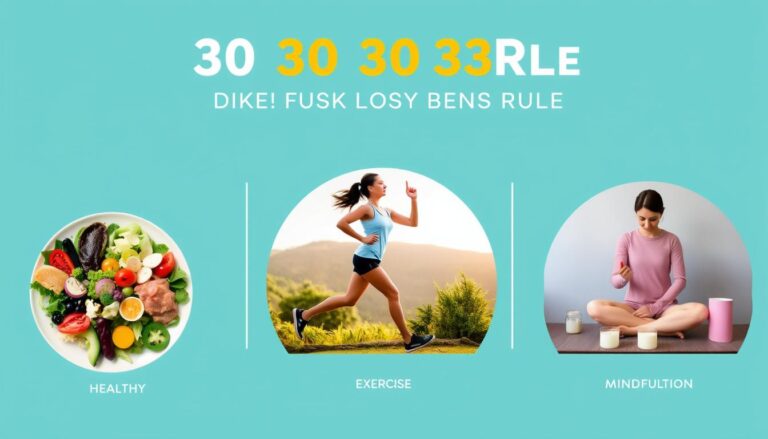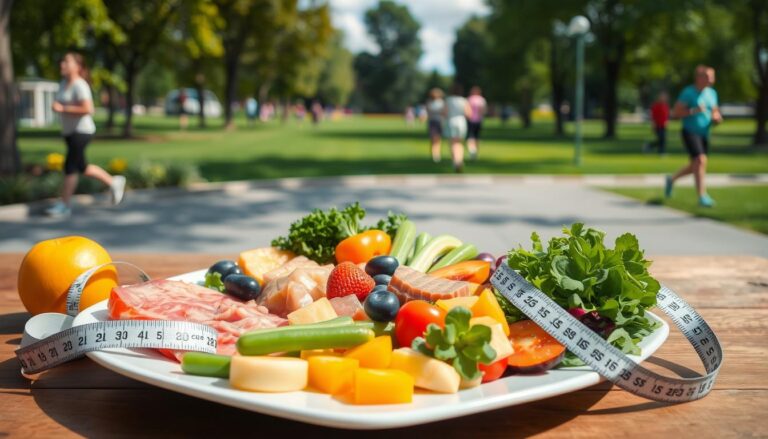Starting a weight loss journey can seem tough. But, losing 10 pounds in a month is doable with the right plan. We’ll look at diet, exercise, and lifestyle changes for healthy weight loss. Setting goals, making a calorie deficit, and more will be covered.
Always talk to a doctor before starting any weight loss plan. This makes sure it’s safe for you.
Key Takeaways
- Set realistic and achievable weight loss goals.
- Create a sustainable calorie deficit through diet and exercise.
- Focus on incorporating whole foods and avoiding processed foods.
- Adopt portion control and hydration practices.
- Monitor progress and stay motivated throughout the journey.
The Importance of Setting Realistic Goals
Setting realistic weight loss goals is key when trying to lose weight. It’s easy to dream big at the start of a fitness journey. But, setting goals that are reachable helps keep motivation up and prevents burnout.
Using the SMART method is a good idea. It means setting goals that are Specific, Measurable, Achievable, Relevant, and Time-bound. For example, instead of just wanting to lose weight, aim to lose 5 pounds in a month. You can do this by exercising for 30 minutes, five times a week, and eating 500 calories less each day.
Small wins are very important. Reaching small goals boosts motivation and confidence. This makes it easier to aim for bigger goals later on. Setting goals that are achievable helps me make steady progress and avoid getting frustrated.
It’s also key to check and change your goals often. As I get better, what was hard before becomes easier. This lets me set new, slightly tougher goals. This keeps me committed to my fitness journey for the long haul.
When setting weight loss targets, knowing about nutrition, exercise, and lifestyle is important. The choice between working out at home versus going to the can affect how well you stick to your fitness plan.
In short, setting realistic goals, using SMART objectives, celebrating small wins, and adjusting plans as needed helps me make lasting progress. This way, I can reach my fitness goals effectively.
Creating a Sustainable Calorie Deficit
For weight loss, a key step is to create a calorie deficit. This means eating fewer calories than your body needs. This helps your body use fat for energy.
Understanding Calorie Intake
Knowing your daily calorie needs is crucial. This number changes based on your age, sex, how active you are, and your weight. Knowing this helps you set a calorie deficit goal. This goal should help you lose weight without harming your health.
Tracking Your Calories
Tracking calories is key to a healthy diet. By logging what you eat, you can keep your calorie intake in check. This helps you make better food choices.
Using Apps to Monitor Calorie Intake
Many apps can make tracking calories easy. These apps let you log your meals and offer insights into your eating habits. This makes it simpler to keep a calorie deficit. Apps like MyFitnessPal, Lose It!, and Fitbit are great for tracking calories and helping you reach your weight loss goals.
| App | Features |
|---|---|
| MyFitnessPal | Easily track your meals and workouts while connecting with a community for support |
| Lose It! | Track food intake with a simple interface and access nutrition information on a vast database |
| Fitbit | Pair with devices to monitor fitness activity along with comprehensive meal tracking |
Healthy Diet Changes for Effective Weight Loss
Making lasting changes to your diet is key for weight loss. Focus on whole foods, avoid processed foods, and balance your macronutrients. This approach will help you lose weight and improve your health.
Incorporating Whole Foods
Whole foods are essential for a healthy diet. They are full of nutrients, fiber, and antioxidants. Adding fruits, veggies, lean proteins, and whole grains to your meals is a great start.
Avoiding Processed Foods
Processed foods can hinder your weight loss efforts. They often have unhealthy fats, added sugars, and too much sodium. Switching to whole foods can help you eat fewer calories and feel better. This change can boost your digestion, energy, and help you lose weight for good.
Balancing Macronutrients
Getting the right balance of macronutrients is vital. Proteins, fats, and carbs give your body the energy and nutrients it needs. The right mix helps you lose weight, keep muscle, and stay energetic.
Here’s a quick overview of how you can balance your macronutrients:
| Macronutrient | Role | Examples |
|---|---|---|
| Proteins | Muscle repair and growth | Chicken, fish, beans, legumes |
| Carbohydrates | Primary energy source | Whole grains, fruits, vegetables |
| Fats | Support brain function | Avocados, nuts, olive oil |
By focusing on whole foods, avoiding processed foods, and balancing your macronutrients, you can make lasting changes. These changes will help you lose weight and improve your health. Aim for a sustainable, healthy lifestyle, not just a quick fix.
How to Lose 10 Pounds in a Month?
Starting a good weight loss plan is key to losing 10 pounds in 30 days. First, set weekly goals that you can reach. This makes losing weight easier and more likely to happen.
In the first week, start a routine that you can keep up. Watch how many calories you eat each day. Use a journal or app to help you stay on track. Good habits at the start will keep you going.
By the second week, keep moving forward by changing your workouts. Mix cardio and strength training to get the best results. Try different exercises like those in this cable workout guide for a well-rounded fitness plan.
In week three, focus more on what you eat. Eat less processed food and more whole foods. This can really help you lose weight faster. Make sure your meals have the right mix of nutrients for your health.
The last week is about making your changes stick. Keep track of how you’re doing, make small changes, and stay excited about your progress. A good weight loss plan is flexible and changes with you.
| Week | Focus | Key Activities |
|---|---|---|
| Week 1 | Routine Establishment | Track calories, set goals, start light exercises |
| Week 2 | Exercise Variation | Incorporate cardio and strength training, follow a cable workout guide |
| Week 3 | Dietary Changes | Reduce processed foods, increase whole foods, balance macronutrients |
| Week 4 | Refinement | Track progress, adjust as needed, maintain motivation |
Effective Exercise Routines
To lose 10 pounds in a month, you need good exercise routines. A mix of cardio workouts and strength training is key. Let’s look at the different exercises and their benefits.
Cardio Workouts
Cardio workouts burn calories fast and improve heart health. Jogging, cycling, and swimming raise your heart rate. This leads to more fat burn.
- Jogging
- Cycling
- Swimming
- Skipping Rope
Doing 30 minutes of intense cardio daily can speed up weight loss.
Strength Training
Strength training is also vital. It builds muscle and boosts metabolism. Exercises like weight lifting, resistance bands, and bodyweight exercises strengthen muscles.
- Weight Lifting
- Resistance Band Exercises
- Bodyweight Exercises (e.g., push-ups, squats)
Do strength training three times a week to keep muscles and improve fitness.
Combining Cardio and Strength
Mixing cardio and strength workouts is great. It burns calories, keeps muscles, and boosts metabolism.
| Day | Activity |
|---|---|
| Monday | Cardio (Running) |
| Tuesday | Strength Training (Weights) |
| Wednesday | Cardio (Cycling) |
| Thursday | Strength Training (Resistance Bands) |
| Friday | Cardio (Swimming) |
| Saturday | Strength Training (Bodyweight) |
| Sunday | Rest or Light Activity (e.g., walking) |
By mixing cardio and strength, you get big benefits. This makes losing weight effective and lasting.
Importance of Portion Control
Learning to control portions is key for losing weight. It helps us reach our fitness goals without extreme diet changes. It’s not about cutting out food, but about eating the right amount.
Using smaller plates and bowls is a smart move. It makes your food look bigger, helping you eat less. Also, portioning snacks before eating them can help manage how much you eat.
Knowing the right serving sizes is also important. For example, a protein serving is like a deck of cards or the size of your hand. Vegetables should fill half your plate. Here’s a table to help:
| Food Type | Recommended Serving Size | Visual Cue |
|---|---|---|
| Protein (e.g., chicken, fish) | 3 ounces | Deck of cards |
| Grains (e.g., rice, pasta) | 1/2 cup | Half a tennis ball |
| Vegetables | 1 cup | Fist |
| Fruits | 1 cup | Baseball |
These visual guides can really help with portion control. They help keep your diet balanced. Using these tips can help you reach and keep your weight loss goals.
Staying Hydrated
Drinking enough water is key for good health and helps with weight loss. It boosts your metabolism and keeps you full. This can stop you from eating too much.
Benefits of Water
Water does more than just quench thirst. It helps with digestion, boosts metabolism, and improves muscle function. It also helps keep your body temperature right and gets rid of waste.
Exercises like cable workouts for arm strength need water to work best. It helps muscles perform well and recover fast.
How Much Water Should You Drink?
How much water is right for you? The usual advice is eight 8-ounce glasses a day. But, your needs can change based on your age, weight, how active you are, and where you live.
Drinking water little by little all day is better than drinking a lot at once. It helps you stay hydrated and supports your body’s needs.
Managing Stress and Sleep
Stress and sleep are key for weight loss. High stress can lead to bad eating habits. This can stop your weight loss plans. Also, good sleep is important for losing weight, as bad sleep can slow you down.
The Impact of Stress on Weight Loss
Stress makes your body want to eat more. It can make you crave foods high in calories. This can cause weight gain or slow down weight loss.
Techniques like deep breathing, yoga, and meditation help manage stress. Find what works for you to stay balanced.
Quality Sleep for Better Results
Good sleep is also vital for weight loss. Not enough sleep messes with your hunger hormones. This makes you want to eat more.
Try to sleep 7-9 hours each night. A regular sleep schedule and a comfy sleep area help a lot.
Stress management and good sleep are key to losing weight. A rested and calm mind helps you reach your health goals.
Tracking Progress and Staying Motivated
Staying motivated on a weight loss journey can be tough. But tracking your progress can really help. I keep a weight loss journal to stay focused and positive.
Digital tools like apps are also great for tracking. They let you log your food, exercise, and measurements. This keeps you reminded of your hard work and keeps you motivated.
It’s also important to celebrate your milestones. Small wins can boost your motivation. Treat yourself to something new or enjoy a special activity. For more tips, check out this comprehensive guide.
Tracking your progress doesn’t have to be hard. Here are some easy ways:
- Weekly weigh-ins
- Taking body measurements
- Photo comparisons
- Using digital apps
Staying consistent with these methods shows your progress. Even small steps are victories. Focus on these tips to make your journey more rewarding.
Healthy Eating Habits for Long-term Success
Keeping a healthy diet is key for losing weight and staying healthy. Mindful eating is a great way to change how you see food. It makes eating more enjoyable and helps you eat right.

Mindful Eating
Mindful eating means paying close attention to eating. It’s about enjoying every bite and listening to your body. This way, you eat better and enjoy food more.
Adding mindful eating to your day helps you eat better for a long time. It helps you choose foods that are good for you.
Healthy Snacking
Snacking wisely is important for a healthy diet. Pick snacks that are good for you, like nuts, fruits, and yogurt. These snacks keep you full and give you energy.
Smart snacking keeps your energy up and helps you stay on track with your diet. It’s good for your weight and health.
Conclusion
Looking back at your weight loss journey is truly inspiring. You set realistic goals and made healthy diet changes. This shows your strong commitment and determination.
Effective exercise routines and portion control were key to your success. Now, it’s important to keep these habits to keep losing weight. Drinking water and managing stress and sleep are also crucial for your health.
Keep tracking your progress and stay motivated. Healthy eating habits and mindful eating are important for long-term health. Remember to keep these tips in mind as you move forward, ensuring your wellness and vitality continue.
FAQ
How can I lose 10 pounds in a month?
To lose 10 pounds in a month, eat less and exercise more. Eat healthy foods and drink lots of water. Also, set goals that are easy to reach.
What are some effective weight loss tips?
Good tips include tracking calories and eating whole foods. Avoid processed foods and balance your diet. Mix cardio and strength training for best results.
How important is setting realistic weight loss goals?
Setting realistic goals is very important. It keeps you motivated and helps you make steady progress. Aim for goals that are specific, measurable, achievable, relevant, and time-bound.
What is a sustainable calorie deficit?
A sustainable calorie deficit means eating fewer calories than you burn. But don’t eat too little. This helps you lose weight without feeling tired or hungry.
How can I track my calorie intake?
Use apps like MyFitnessPal or Lose It! to track calories. They help you log your food and see how much you’re eating.
What are the benefits of incorporating whole foods into my diet?
Whole foods are full of nutrients and don’t have added sugars or bad fats. They help you feel full longer and give you important vitamins and minerals.
Why should I avoid processed foods?
Processed foods have a lot of sugar, salt, and bad fats. They can stop you from losing weight and cause health problems like obesity and heart disease.
What is the role of macronutrient balance in weight loss?
Eating the right mix of proteins, fats, and carbs gives your body what it needs. It helps you lose weight and stay healthy.
How often should I exercise to lose weight?
Exercise at least 150 minutes a week, doing moderate cardio. Also, do strength training two times a week. This burns calories and builds muscle.
How can portion control aid in weight loss?
Portion control helps you eat the right amount of food. Use small plates and measure your food. This helps you stay within your calorie limit.
What are the benefits of staying hydrated?
Drinking enough water boosts your metabolism and makes you feel full. It also helps with digestion. Drink 8-10 glasses of water a day to help with weight loss.
How does stress impact weight loss?
Stress can make you eat more and affect your hunger hormones. Managing stress with meditation or exercise can help you lose weight better.
How does sleep affect weight loss?
Good sleep helps control hunger and energy levels. Aim for 7-9 hours of sleep a night to support your weight loss.
How can I stay motivated throughout my weight loss journey?
Use apps or journals to track your progress. Celebrate small wins and have a support system. Stay focused on your long-term goals and be patient.
What is mindful eating, and how can it help in weight loss?
Mindful eating means paying attention to when you’re hungry or full. Eat slowly and enjoy your food. It helps you avoid overeating and choose healthier foods.
Are there any healthy snacking options for weight loss?
Yes, choose snacks like fruits, veggies, nuts, and seeds. They’re full of nutrients and won’t add too many calories.






